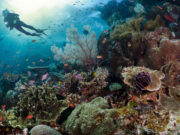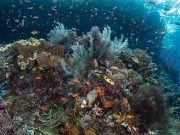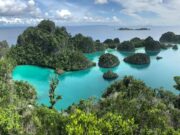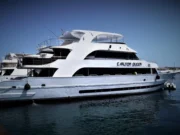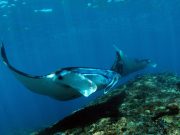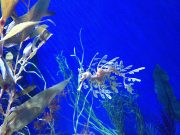The Republic of Palau, a South Pacific island nation, is the world’s first country to ban sunscreen products containing environmentally harmful ingredients.
Palau’s Responsible Tourism Education Act of 2018, which takes effect in 2020, prohibits use of environmental pollutants that threaten juvenile stages of corals, fish and other marine life. The banned substances contain sun protection factor (SPF) chemicals used in sunscreen lotions or fragrances that absorb ultraviolet sunlight. These include oxybenzone, octinoxate, octocrylene, 4-methyl-benzylidene camphor and parabens. The parabens triclosan and phenoxyethanol are antimicrobial preservatives also used in shampoos, moisturisers, liquid soaps and hair conditioners.
Scientists have shown that oxybenzone, for example, coming from swimmers’ skin, municipal sewage discharge and coastal septic systems pollutes coral reefs. “We found that oxybenzone caused gross morphological deformities, DNA damage and endocrine disruption, which causes the coral to close up and die,” explains Prof. Ariel Kushmaro, head of the Environmental Biotechnology Lab at Ben-Gurion University.
The ban follows a similar move in Hawaii earlier this year. On May 4, the Hawaii legislature banned oxybenzone (BP3) beginning in 2021 in an attempt to prevent coral bleaching, a condition by which corals expel the algae (zooxanthellae) living in their tissues causing the coral to turn completely white.
Marine biologists and environmentalists, including the U.S. National Oceanic and Atmospheric Administration (NOAA), say the banned substances can reduce the resiliency of ecosystems to climate change factors and, by themselves, prevent the recovery of degrading wildlife and habitats. The resulting damage to coral reefs, including coral bleaching, in the South Pacific, Caribbean, Australia, Israel, and elsewhere poses a threat to one-quarter of marine species, and threatens shorelines and vibrant tourism in affected areas.
Which sunscreens are safe to use?
Look for ones without the ingredients mentioned above. Zinc oxide and Titanium dioxide are good as long as they are not in nano-format. A quick guide is whether the sunscreen is clear or not. If it is clear, or in a spray, it probably contains nano-particles.
If the ingredients state “uncoated” zinc oxide then these are larger particles (non-nano) and safe.
There are now many options for sunscreens which are not harmful to sea life, including:
Odylique sunscreen
Badger Sunscreen
Shade all-natural sunscreen
Why Palau?
Palau, a tiny archipelago of approximately 300 islands located 400 miles southeast of the Philippines, has long been a pioneer in marine protection, introducing the world’s first shark sanctuary in 2009. It is also known as one of the world’s best diving destinations.
Sharks, Mantas and Spotted Eagle Rays in Palau by Matthew Moore






